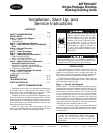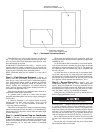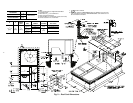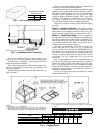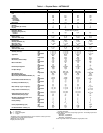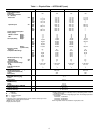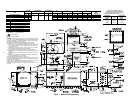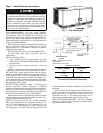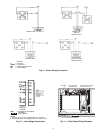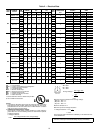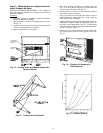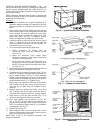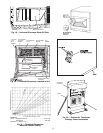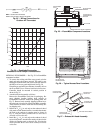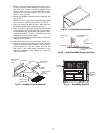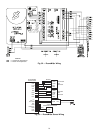
8
Step 7 — Make Electrical Connections
FIELD POWER SUPPLY — All units except 208/230-v
units are factory wired for the voltage shown on the nameplate.
If the 208/230-v unit is to be connected to a 208-v power sup-
ply, the transformer must be rewired by moving the black wire
with the
1
/
4
-in. female space connector from the 230-volt con-
nection and moving to the 200-volt
1
/
4
-in. male terminal on the
primary side of the transformer.
Refer to unit label diagram for additional information. Pig-
tails are provided for field wire connections. Use factory-
supplied splices or UL (Underwriters’ Laboratories) approved
copper/aluminum connector.
When installing units, provide a disconnect per the NEC.
All field wiring must comply with NEC and local
requirements.
Install field wiring as follows:
1. Install conduit through side panel openings. For units
without electric heat, install conduit between disconnect
and control box.
2. Install power lines to terminal connections as shown in
Fig. 9.
Voltage to compressor terminals during operation must be
within voltage range indicated on unit nameplate (see Table 2).
On 3-phase units, voltages between phases must be balanced
within 2% and the current within 10%. Use the formula shown
in the legend for Table 2, Note 2 to determine the percent of
voltage imbalance. Operation on improper line voltage or ex-
cessive phase imbalance constitutes abuse and may cause dam-
age to electrical components. Such operation would invalidate
any applicable Carrier warranty.
FIELD CONTROL WIRING — Install a Carrier-approved
accessory thermostat assembly according to installation
instructions included with the accessory. Locate thermostat as-
sembly on a solid wall in the conditioned space to sense aver-
age temperature in accordance with thermostat installation in-
structions. Connect thermostat wires to terminal board.
Route thermostat cable or equivalent single leads of colored
wire from subbase terminals through connector on unit to low-
voltage connections (shown in Fig. 10).
NOTE: For wire runs up 50 ft, use no. 18 AWG (American
Wire Gage) insulated wire (35 C minimum). For 50 to 75 ft,
use no. 16 AWG insulated wire (35 C minimum). For over
75 ft, use no. 14 AWG insulated wire (35 C minimum). All
wire larger than no. 18 AWG cannot be directly connected to
the thermostat and will require a junction box and splice at the
thermostat.
Pass the control wires through the hole provided in the cor-
ner post; then feed wires through the raceway built into the
corner post to the 24-v barrier located on the left side of the
control box. See Fig. 11. The raceway provides the UL re-
quired clearance between high- and low-voltage wiring.
HEAT ANTICIPATOR SETTINGS — Set heat anticipator
settings at .14 amp for the first stage and .14 amp for second-
stage heating, when available.
Unit cabinet must have an uninterrupted, unbroken electri-
cal ground to minimize the possibility of personal injury if
an electrical fault should occur. This ground may consist of
electrical wire connected to unit ground lug in control com-
partment, or conduit approved for electrical ground when
installed in accordance with NEC (National Electrical
Code), ANSI/NFPA, latest edition, and local electrical
codes. Do not use gas piping as an electrical ground. Fail-
ure to follow this warning could result in the installer being
liable for personal injury of others.
BLOWER
ACCESS
PANEL
LEGEND
NFGC —
National Fuel Gas Code
*Field supplied.
NOTE: Follow all local codes.
SPACING OF SUPPORTS
Fig. 8 — Gas Piping Guide (With Accessory
Thru-the-Curb Service Connections)
STEEL PIPE
NOMINAL DIAMETER
(in.)
X
DIMENSIONS
(feet)
1
/
2
6
3
/
4
or 1
8
1
1
/
4
or larger
10
Fig. 7 — Flue Hood Details



